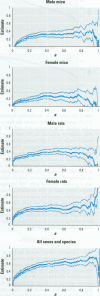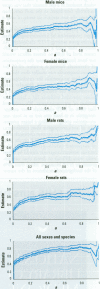Abstract
Estimates were made of the proportion of chemicals that were carcinogenic, anticarcinogenic, or either in 397 long-term bioassays conducted by the National Toxicology Program (NTP). The estimates were obtained from the global pattern of p-values obtained from statistical tests applied to individual experiments. These tests accounted for multiple comparisons using a randomization procedure and were found to operate at the correct level of significance. Representative estimates of the proportion of carcinogens [with 90% confidence intervals (CI)] compared to the NTP estimates were as follows: male mice, 0.32 (CI, 0.19-0.44), NTP = 0.29; female mice, 0. 28 (CI, 0.15-0.41), NTP = 0.34; male rats, 0.35 (CI, 0.23-0.47), NTP = 0.36; female rats, 0.34 (CI, 0.21-0.46), NTP = 0.28; all sexes and species, 0.59 (CI, 0.49-0.69), NTP = 0.51. Representative estimates of the proportion of anticarcinogens were as follows: male mice, 0. 34; female mice, 0.27; male rats, 0.40; female rats, 0.44; all sexes and species, 0.66. Thus, there was as much or more evidence in this study for anticarcinogenesis as carcinogenesis. Even though the estimators used were negatively biased, it was estimated that 85% of the chemicals were either carcinogenic or anticarcinogenic at some site in some sex-species group. This suggests that most chemicals given at high enough doses will cause some sort of perturbation in tumor rates.
Full text
PDF





Images in this article
Selected References
These references are in PubMed. This may not be the complete list of references from this article.
- Ames B. N., Gold L. S. Chemical carcinogenesis: too many rodent carcinogens. Proc Natl Acad Sci U S A. 1990 Oct;87(19):7772–7776. doi: 10.1073/pnas.87.19.7772. [DOI] [PMC free article] [PubMed] [Google Scholar]
- Bailer A. J., Portier C. J. Effects of treatment-induced mortality and tumor-induced mortality on tests for carcinogenicity in small samples. Biometrics. 1988 Jun;44(2):417–431. [PubMed] [Google Scholar]
- Bickis M., Krewski D. Statistical issues in the analysis of the long-term carcinogenicity bioassay in small rodents: an empirical evaluation of statistical decision rules. Fundam Appl Toxicol. 1989 Feb;12(2):202–221. doi: 10.1016/0272-0590(89)90038-9. [DOI] [PubMed] [Google Scholar]
- Crump K. S., Krewski D., Wang Y. Estimates of the number of liver carcinogens in bioassays conducted by the National Toxicology Program. Risk Anal. 1998 Jun;18(3):299–308. doi: 10.1111/j.1539-6924.1998.tb01297.x. [DOI] [PubMed] [Google Scholar]
- Dinse G. E. A comparison of tumour incidence analyses applicable in single-sacrifice animal experiments. 1994 Mar 15-Apr 15Stat Med. 13(5-7):689–708. doi: 10.1002/sim.4780130530. [DOI] [PubMed] [Google Scholar]
- Farrar D. B., Crump K. S. Exact statistical tests for any carcinogenic effect in animal bioassays. Fundam Appl Toxicol. 1988 Nov;11(4):652–663. doi: 10.1016/0272-0590(88)90128-5. [DOI] [PubMed] [Google Scholar]
- Farrar D., Crump K. Exact statistical tests for any carcinogenic effect in animal bioassays. II. Age-adjusted tests. Fundam Appl Toxicol. 1990 Nov;15(4):710–721. doi: 10.1016/0272-0590(90)90187-o. [DOI] [PubMed] [Google Scholar]
- Fung V. A., Barrett J. C., Huff J. The carcinogenesis bioassay in perspective: application in identifying human cancer hazards. Environ Health Perspect. 1995 Jul-Aug;103(7-8):680–683. doi: 10.1289/ehp.95103680. [DOI] [PMC free article] [PubMed] [Google Scholar]
- Fung V. A., Huff J., Weisburger E. K., Hoel D. G. Predictive strategies for selecting 379 NCI/NTP chemicals evaluated for carcinogenic potential: scientific and public health impact. Fundam Appl Toxicol. 1993 May;20(4):413–436. doi: 10.1006/faat.1993.1053. [DOI] [PubMed] [Google Scholar]
- Haseman J. K. A reexamination of false-positive rates for carcinogenesis studies. Fundam Appl Toxicol. 1983 Jul-Aug;3(4):334–339. doi: 10.1016/s0272-0590(83)80148-1. [DOI] [PubMed] [Google Scholar]
- Haseman J. K., Elwell M. R. Evaluation of false positive and false negative outcomes in NTP long-term rodent carcinogenicity studies. Risk Anal. 1996 Dec;16(6):813–820. doi: 10.1111/j.1539-6924.1996.tb00832.x. [DOI] [PubMed] [Google Scholar]
- Haseman J. K., Huff J. E., Zeiger E., McConnell E. E. Comparative results of 327 chemical carcinogenicity studies. Environ Health Perspect. 1987 Oct;74:229–235. doi: 10.1289/ehp.8774229. [DOI] [PMC free article] [PubMed] [Google Scholar]
- Haseman J. K., Johnson F. M. Analysis of National Toxicology Program rodent bioassay data for anticarcinogenic effects. Mutat Res. 1996 Feb 19;350(1):131–141. doi: 10.1016/0027-5107(95)00098-4. [DOI] [PubMed] [Google Scholar]
- Huff J., Cirvello J., Haseman J., Bucher J. Chemicals associated with site-specific neoplasia in 1394 long-term carcinogenesis experiments in laboratory rodents. Environ Health Perspect. 1991 Jun;93:247–270. doi: 10.1289/ehp.9193247. [DOI] [PMC free article] [PubMed] [Google Scholar]
- Huff J. Issues and controversies surrounding qualitative strategies for identifying and forecasting cancer causing agents in the human environment. Pharmacol Toxicol. 1993;72 (Suppl 1):12–27. doi: 10.1111/j.1600-0773.1993.tb01664.x. [DOI] [PubMed] [Google Scholar]







